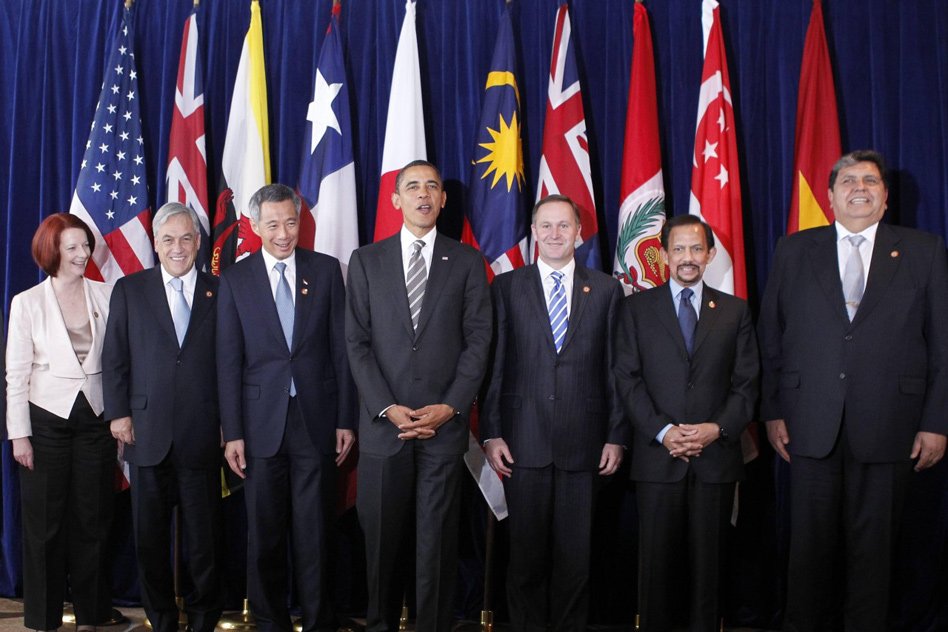Image Source: jacobinmag
The United States, Japan and 10 other Pacific Rim nations recently finalised an agreement on Trans-Pacific Partnership (TPP), the largest regional trade accord in history.
TPP would tie together 40 per cent of the world’s economy. The countries part of this partnership are Australia, Brunei Darussalam, Canada, Chile, Japan, Malaysia, Mexico, New Zealand, Peru, Singapore, United States of America and Vietnam.
What is TPP and why is USA pushing for it?
The Trans-Pacific Partnership (TPP) is a proposed trade agreement between twelve Pacific Rim countries concerning a variety of matters of economic policy, about which agreement was reached on 5 October 2015 after years of negotiations. Among other things, the TPP seeks to lower trade barriers such as tariffs, establish a common framework for intellectual property, enforce standards for labour law and environmental law, and establish an investor-state dispute settlement mechanism.
The United States government has considered the TPP as complementing the Transatlantic Trade and Investment Partnership (TTIP), a similar agreement between the United States and the European Union.
But that is not all. The Obama government sees the TPP as an instrument to contain and counter the growing rise of China in the region.
What will it do?
TPP would phase out thousands of import tariffs as well as other barriers to international trade, like those that the participating countries have placed on American exports, including autos, machinery, information technology and consumer goods, chemicals and agricultural products. It would also establish uniform rules on corporations’ intellectual property, and open the Internet even in communist Vietnam.
It would overhaul the system for settling disputes between nations and foreign companies. Negotiators said it also would enforce higher standards for labour conditions and environmental protection, including wildlife-trafficking.
A big hurdle- US Congress
Now that an agreement has been reached, the deal faces months of scrutiny in US Congress. This debate will happen against the backdrop of a presidential campaign in which populist anti-trade talk against the deal is already prominent.
Still, for Mr Obama the accord could be a legacy-making achievement. It includes both his economic agenda to expand exports and his foreign policy ‘rebalance’ toward closer relations with fast-growing eastern Asia, after years of American preoccupation with the Middle East and North Africa.
Why Hasn’t China Been In on the Talks?
China has never expressed interest in joining the negotiations, but in the past has viewed the pact with concern, seeing a potential threat as the United States tries to tighten its relationship with Asian trading partners. But recently, as the negotiations reached conclusions, senior Chinese officials have sounded more accepting of the potential deal, and have even hinted that they might want to participate at some point. At the same time, the deal provides China some cover as it pursues its own trade agreements in the region, such as the Silk Road initiative in Central Asia.
United States officials make clear that they see the pact as part of an effort to counter China’s influence in the region.
Opposition to the deal
Not everyone is happy with the agreement. A number of global health professionals, internet freedom activists, environmentalists, organised labour, advocacy groups, and elected officials have criticised and protested against the treaty, in large part because of the secrecy of negotiations, the agreement’s expansive scope, and controversial clauses in drafts leaked to the public.
India and the TPP
Some foreign policy experts believe India’s addition to the Trans-Pacific Partnership (TPP) trade agreement, linking together major economies in North America, South America, the Pacific, and Southeast Asia, “would only enhance the TPP’s transformative potential.” They argue that adding the world’s largest democracy, and a BRICS nation, would represent a symbolic victory for the pact.
If India joins the TPP in the future, it gives us the opportunity to gain preferential access to thriving and fast-growing markets in Southeast Asia, in addition to that of Canada, Japan, Mexico, and the United States.











